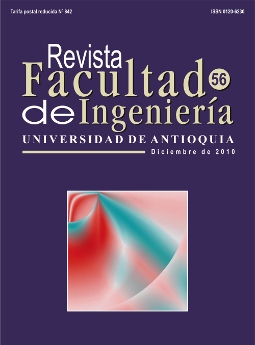Parameter optimization in general Scan methods
DOI:
https://doi.org/10.17533/udea.redin.14670Keywords:
fuzzy logic, non parametric experimental design, Scan methodAbstract
The present work shows an application of Experimental Design to the methods for disease cluster detection: Classic Scan and Fuzzy Scan. A non parametric experimental design for two factors is used. The fundamental target is to study the influence of the values of the parameters: the length width and the Scan step in order to determine optimum values.
Downloads
References
G. Jacquez, L. Waller, R. Grimson, D. Watenberg. “A k-nearest neighbor test for space-time interaction”. Stat. in Med. Vol. 15. 1996. pp. 1934-49. DOI: https://doi.org/10.1002/(SICI)1097-0258(19960930)15:18<1935::AID-SIM406>3.0.CO;2-I
M. D. Joner, W. H. Woodall, M. R. Reynolds. “Detecting a rate increase using a Bernoulli scan statistic”. Statistics in medicine. Vol. 27. 2008. pp. 2555-2575 DOI: https://doi.org/10.1002/sim.3081
R. Marshall. “A review of methods for the statistical analysis of spatial patterns of disease”. J. of the Royal Stat.l Soc. Assoc. Vol. 154. 1991. pp. 421 441. DOI: https://doi.org/10.2307/2983152
J. Glaz. “Aproximations for the tail probabilities and moments of the Scan statistics”. Statistics in medicine. Vol. 12. 1993. pp. 1845-1852. DOI: https://doi.org/10.1002/sim.4780121911
J. Glaz, N. Balakrishnan. “Scan Statistics and Applications”. Birkauser. Statistics for Industry and Technology. Ed. Hardcover. Boston. 1999. pp. 269- 284. DOI: https://doi.org/10.1007/978-1-4612-1578-3
J. Glaz, J. Naus, S. Wallenstein. Scan Statistics. Ed. Springer Verlag. New York. 2001. pp. 81-96.7. DOI: https://doi.org/10.1007/978-1-4757-3460-7_6
J. I. Naus. “Approximations for distributions of Scan statistics”. Journal of the American Statistical Association. Vol. 77. 1982. pp. 177-183. DOI: https://doi.org/10.1080/01621459.1982.10477783
M. Kulldorff, F. Mostashari, L. Duczmal, K. Yih, K. Kleinman, R. Platt. “Multivariate scan statistics for disease surveillance”. Statistics in Medicine. Vol. 26. 2007. pp. 1824-1833. DOI: https://doi.org/10.1002/sim.2818
C. E. Priebe, J. M. Conroy, D. J. Marchette, Y. Park. “Scan Statistics on Enron Graphs “. Computational & Mathematical Organization Theory. Vol. 11. 2005. pp. 229-247. DOI: https://doi.org/10.1007/s10588-005-5378-z
C. Langrand. “Scan Statistics: definición y ejemplos”. Seminario ANY 2005. Ed. Université Sciences et Technologies de Lille (Lille-1). Universidad Politécnica de Cataluya. Valencia (España). 2005. pp. 1-11.
A. W. Martin. “A Generalised Scan Statistic Test for the Detection of Clusters”. International Journal of Epidemiology. Vol. 10. 1981. pp. 289-293. DOI: https://doi.org/10.1093/ije/10.3.289
R. Nussbaum, L. Peltonen. “Genetics of disease: Recent advances in the genetics of human disease offer something new for every scientific interest “. Current Opinion in Genetics & Development. Vol. 17. 2007. pp. 163-165. DOI: https://doi.org/10.1016/j.gde.2007.03.003
P. Baldi, S. Brunak. Bioinformatics: the machinelearning approach. 2 ed. Ed. MIT Press. New York. 2001. pp. 47-241.
L. A. Zadeh. “Nacimiento y evolución de la Lógica Borrosa, el soft computing y la computación con palabras: un punto de vista personal”. Psicothema. Vol. 8. 1999. pp. 421-429.
L. Rodríguez, G. Casas, R. Grau, M. Pupo.“Generalización de dos métodos de detección de conglomerados. Aplicaciones en Bioinformática.” Revista de Matemática: Teoría y Aplicaciones. Vol. 15 2008. pp. 27 - 40. DOI: https://doi.org/10.15517/rmta.v15i1.286
L. Rodríguez, G. Casas, R. Grau. “Linear FuzzyScan Method to Detect Clusters. A Bioinformatic Application”. XIV Latin Ibero-American Congress on Operations Research (CLAIO 2008).Ed. Cartagena de Indias. Colombia. 2008. pp. 536-540.
L. Rodríguez, G. Casas, R. Grau, O. Gómez. “Approximations for the distribution of Fuzzy Scan Statistics”. Investigación Operacional. Vol. 30. 2009. pp. 131-139.
L. Rodríguez, G. Casas, R. Grau, Y. Martínez. “Fuzzy Scan Method to Detect Clusters”. International Journal of Biomedical Sciences. Vol. 3. 2008. pp. 111-115.
L. Rodríguez, G. Casas, R. Grau. “Aplicación de los métodos Scan en Bioinformática”. Uciencia 2006. II Conferencia Científica. Ed. UCI. La Habana. 2006. pp. 13-18.
L. Rodríguez, G. Casas, R. Grau. “Validación del método Scan Generalizado con verdaderos falsos conglomerados”. X Congreso Nacional de Matemática y Computación. Ed. Holguín. Holguín. (Cuba). 2007. pp. 21-24.
L. Rodríguez, G. Casas, R. Grau, G. Cardoso, S. Ortega, M. Pupo. “Scan Statistics. Bioinformatics Applications”. First International Workshop on Bioinformatics Cuba-Flanders. Ed. UCLV. Santa Clara (Cuba). 2006. pp. 33-39.
B. Martín del Brío, A. Sánchez. Redes Neuronales y Sistemas Difusos. 2ª ed. Ed. Alfaomega. México. 2005. pp. 241-341.
D. C. Montgomery. Diseño y Análisis de Experimentos. Ed. Limusa. México. 2008. pp. 686.
R. R. Sokal, F. J. Rohlf. „The principles and practice of statistics in biological research.“ Biometry. 3ª ed. Ed. W. H. Freeman and Company. New York. 1995. pp. 123-234.
K. Alakurtti, E. Weber, R. Rinne, G. Theil, D.
Lindhout, P. Salmikangas, P. Saukko, U. Lahtinen. “Loss of lysosomal association of cystatin B proteins representing progressive myoclonus epilepsy, EPM1, mutations”. Hum Genet.Vol. 13. 2005. pp. 208-215. DOI: https://doi.org/10.1038/sj.ejhg.5201300
Downloads
Published
How to Cite
Issue
Section
License
Copyright (c) 2018 Revista Facultad de Ingeniería

This work is licensed under a Creative Commons Attribution-NonCommercial-ShareAlike 4.0 International License.
Revista Facultad de Ingeniería, Universidad de Antioquia is licensed under the Creative Commons Attribution BY-NC-SA 4.0 license. https://creativecommons.org/licenses/by-nc-sa/4.0/deed.en
You are free to:
Share — copy and redistribute the material in any medium or format
Adapt — remix, transform, and build upon the material
Under the following terms:
Attribution — You must give appropriate credit, provide a link to the license, and indicate if changes were made. You may do so in any reasonable manner, but not in any way that suggests the licensor endorses you or your use.
NonCommercial — You may not use the material for commercial purposes.
ShareAlike — If you remix, transform, or build upon the material, you must distribute your contributions under the same license as the original.
The material published in the journal can be distributed, copied and exhibited by third parties if the respective credits are given to the journal. No commercial benefit can be obtained and derivative works must be under the same license terms as the original work.










 Twitter
Twitter